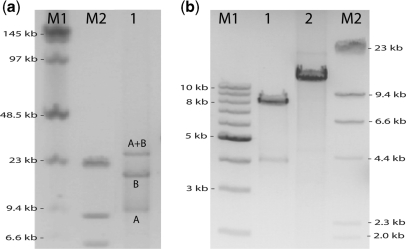Figure 2.
End-joining very long DNA. (a) Pulsed field electrophoresis gel image illustrating the efficient end-joining of two very long DNA molecules. Lane 1 contains the product after joining a 20 kb (A) DNA molecule to a 9.6 kb (B) DNA molecule using our two step protocol. Using markers M1 and M2 as a reference, we can see bands corresponding to the molecules A, B, and an additional band corresponding to DNA longer than 23 kb, which is likely the A + B dimer of ∼30 kb DNA. The efficiency of dimer formation (∼50%) is similar to that of the shorter molecules in Figure 1. (b) Pulsed field electrophoresis image illustrating that the ligation efficiency to join two molecules is strongly reduced for longer molecules: In lane 1 we show the ligation of a 4.2 kb long DNA molecule to itself (the molecules have a small self-complementary overhang), which clearly has a very high efficiency of about 90%, judging from the relative intensity of the band at about 8.5 kb DNA. However, the ligation of a 12.7 kb molecule with exactly the same overhang is much less efficient: a band at ∼25 kb is not observed.

